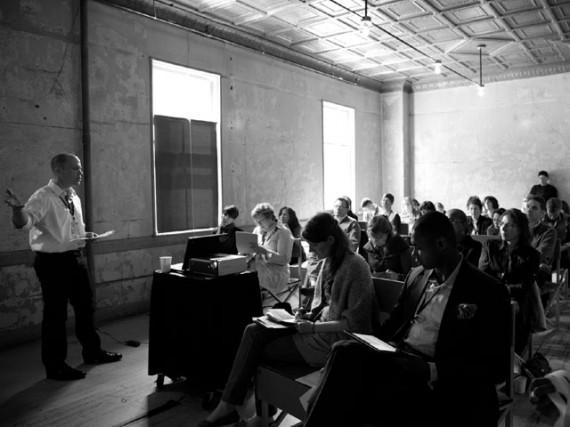Dealing with Shrinking Budgets, Sessions I & II

Many of the dynamic discussions within your organization assume that the future will not – must not – look like the past. But have your practices and understanding of financial management kept pace? Come share and learn about ways in which your peer organizations are breaking through “deficit thinking,” whether by revisiting financial fundamentals or making structural changes to their thinking and approach.
Led by Ben Aase, LarsonAllen.
Aase opened the session with a rhetorical question: “We hear over and over again that proper capitalization and sustainability are important…but how do we get there?”
“You’re here to share and learn about way in which you and your peer organizations are breaking through deficit thinking,” he continued, “whether by revisiting financial fundamentals or making structural changes to your thinking and approach.”
That the recession throttled philanthropy was old news to the room, but Aase had the numbers: although there was a 2% increase in giving this past year, the previous five years philanthropy was in free fall. After a quick run through “recession lessons” gleaned from clients—short quotes such as “Budgeting from the revenue side can be suicide”—Aase turned to figures from a Nonprofit Finance Fund survey that showed, among other things, that 23% percent of the 1,935 nonprofits surveyed didn’t feel that their funders were willing to engage in open dialog about financial challenges.
That may be why figures from the same survey show that the top four priorities for nonprofits include engaging more closely with their boards, developing or maintaining “worst-case scenario” contingency budgets. The help organizations want most includes fundraising assistance, tools to communicate their financial picture to boards and/or funders, and financial scenario planning. Nearly half of the nonprofits surveyed planned to pursue revenue more aggressively. By now, Aase said, they’ve cut close to bone and are looking for transformative model changes.
Aase emphasized the need for adaptability, budgeting, moving beyond negative feelings about budgeting, and adhering to process principles on the way to those transformative models. He also shared a “portfolio approach” for linking an organization’s business model with its budget. The images from his presentation, with an excellent outline of his main points and sources, follow.
DEALING WITH SHRINKING BUDGETS, PART II – LATE AFTERNOON SESSION
Ben Aase opened the session with a general overview of the field with a content rich PowerPoint presentation also made available in hard copy. Overall, giving slightly recovered in 2010 but probably won’t reach pre-recession levels until around 2016 and corporate and government support is lagging. In this landscape creating an agile business plan and budget are necessary for organizations to remain competitive.
Budgeting fundamentals hold true today as always. A budget can translate and organization’s goals and aspirations into financial terms, provide a framework for making difficult program decisions, and hold boards and the organization accountable.
Those negative feelings of anxiety elicited by budget discussions are typically reactions to the potential limits a budget may expose and the risk-taking those restrictions often imply. Aase recommends picking up a copy of the book “Business Model Generation” and paying attention to the “12 Beyond Budgeting Principles”. This innovative book was designed and created through online open-source style collaboration. Through the Beyond Budgeting Principle Roundtable, free-thinking was introduced into the traditional command and control approach to financial management. This approach asserts that leadership and agency empower fiscal accountability and that performance principles based on goals and rewards strengthen planning.
There are multiple approaches to creating a budget. One is the portfolio approach which is adaptive during time of tough decision making. Another helpful framework is Mission, Market and Money, a true cost and forecasting exercise through which various stakeholders can evaluate and discuss their organizations financial health through a more subjective lens. Often, this exercise results in a moment of clarity for board members and staff.
The term “Business Model” is quite loaded and very few people actually agree on its meaning. The Business Model Canvass, provided by Aase, integrates budget and cash flow into overall value projection. This is another good exercise to engage Board members in to revitalize their interest and investment within the organizations overall operations.
Capitalization! Aase referenced a moment in the previous session in which an attendee proposed that her role as executive director was to make sure her organization had a well capitalized balance sheet.* Capitalization is important because budgets can only illuminate a certain point in time. Budgets do not address context such as an organization’s financial history, resources, and goals. One attendee’s organization confronted this dilemma by looking at their current budget and then drafting an budget projected over six years. In so doing they were able to better map their resources and assure themselves that the organization, despite its current struggles, was moving in the right direction.
Strategic Plans are another method of assessing an organizations financial health and planning for the future. Strategic plans should generally be revisited and revised every 3-5 years or else during a major organizational crisis or shift. The current trend is moving away from a narrative plan toward tools and decision making frameworks. It’s important to note that, for the most part, a strategic plan and business model are the same thing.
Although budget evaluations in this climate can lead to tough decisions, the consequences of those decisions may be positive. One Executive Director in attendance conceded that, although her organization had elected after a budget review to cut her salary, the decision resulted in a more proactive Board increasingly involved with the daily operations of the organization. When members who previously strayed toward the sidelines were brought into the fold, they began to identify opportunities for earned income to supplement scarce grant funding.
Another attendee validated the impact volunteers can have on their organizations health and stability. Aase pointed out that when volunteers and in-kind donations are taken for granted so is a large portion of the budget. Further, the ability to discuss Business Models beyond numbers encourages both old and new boards member to pursue shared goals.
Due to the near elimination of art funding in Kansas, Salinas Art Center inquired about diversifying revenue streams. Some people recommended space rentals as long thoughtfully balanced with programming. Another suggested partnering with other nonprofit organizations on outsourcing collateral production at discount rates (although admittedly this method didn’t work for his organization). Another advocated recruiting well networked individuals as Board Members and leveraging their contacts to contribute to fundraising efforts. Experimenting with the format of fundraising events is an effective way to evaluate and maximize revenue earned from these occasions. Other options include merging back-office operations with other organizations or dropping one 501(c)(3) status and opting for fiscal sponsorship.
PowerPoint Presentations and Supporting Documents (pdf format):
2011 WIC – Dealing With Shrinking Budgets
Small Nonprofit Savings
Small Nonprofit Tech Savings
Business Model Canvas Poster
Related Links:
Nonprofit Finance Fund
Kresge Foundation Institutional Capitalization Program
Business Model Generation


